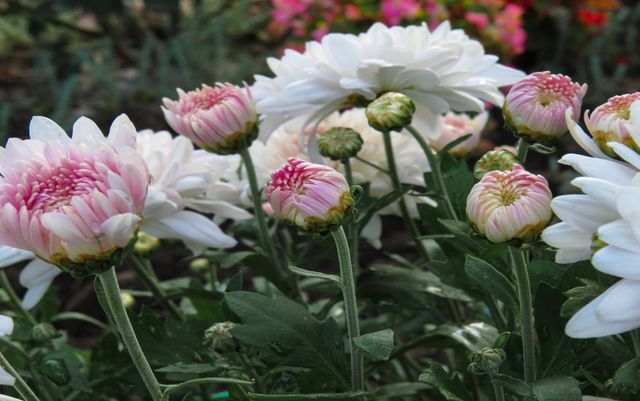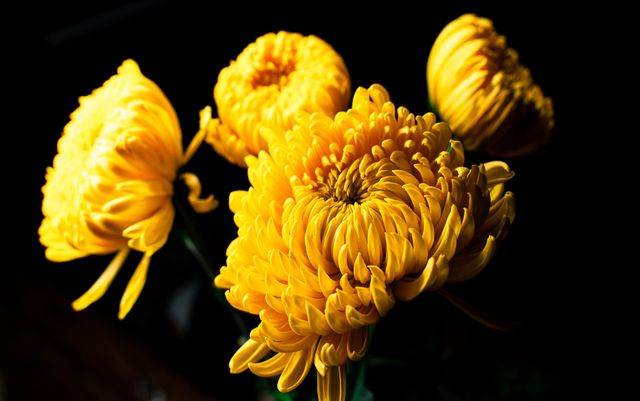Introduction
A garden brimming with colorful flowers of Chrysanthemum is every gardener’s dream and delight.
No doubt, a winter garden would be incomplete without these perennial flowering plants often called ‘mums.’
Also named the ‘Glory of the east’, Chrysanthemums are among the most widely cultivated garden flowers & rank probably next to Roses in popularity.
There is hardly any other garden flower except roses and chrysanthemum, which have such a diverse and beautiful range of colorful shades, widely different flower shapes, & height ranges.
Plant overview
Chrysanthemums are members of the Compositae family and are available throughout the world in a wide range of brilliant shades, shapes, and sizes.
The color range of this flower ranges from dazzling whites to deep bronzes, and these hardy plants make their appearance with full, dark green leaves.
This beautiful flowering plant was first cultivated in China over 6 centuries ago.
It was initially grown as a herb that is associated with the power of life.
These flowers are beautiful ones that look like they have a multitude of petals, but each of the individual petals is actually a small floret.
In general, there are two different types of florets: ray and disc florets. Ray florets are the general ones that we traditionally see as the petals, whereas the disc florets create the center buttons.
When these two florets are all clustered with each other they give us a beautiful chrysanthemum flower that we used to look at.
Varieties of Chrysanthemum to grow

Chrysanthemum ‘Leading Lady’
This variety of this flower grows giant, incurved, soft pink blooms in late summer. This plant is a half-hardy, early-flowering type that reaches up to the height of 120cm.
Chrysanthemum ‘Early Yellow’
This variety of this flower is a fully hardy perennial that grows small single flowers from July to October. This beautiful yellow variety reaches up to the height of 80cm.
Chrysanthemum ‘Spartan Fire’
Chrysanthemum Spartan fire reflected red flowers with the underside of the petals that colored gold. This plant is fully hardy perennial reaching upto the height of 1m.
Chrysanthemum ‘Foggy’
Chrysanthemum foggy is a late-flowering type of plant used for indoor display. Flexed with Lime-green pom flowers from November, this flowering plants grow upto the height of 80cm. Plant Breeders’ Right protects this plant.
Chrysanthemum ‘Bruno Bronze’
Chrysanthemum Bruno Bronze is a tender orange-colored flowering plant that flowers from September to November. This plant attained the size of 1m.
When to grow chrysanthemum?
It is always recommended to plant the chrysanthemum in the spring so that the perennial plant can get time to establish and adapt to its new garden home.
You may easily find this plant in garden centers and nurseries in both the fall and spring seasons, but planning ahead is key to successful planting.
You might be tempted to buy those huge beautiful fall varieties you see during the autumn season, but The smaller spring mums are a better investment in terms of longevity.
If you plant this plant during spring, the root system will get time to become stronger throughout the summer and fall, which increases the ability of the plant to survive the winter. It results in a bigger bloom the following season.
How to Plant a Chrysanthemum Plant?

Growing a healthy and flowering chrysanthemum depends on choosing the appropriate variety of the plant.
You may find attractive plants in the garden centers or near the florist, but they might not be the perfect ones because they may have limited root systems.
Buy the rooted cuttings or the small plants from the garden center. Pot these plants into individual pots of 10cm. Pot on the plant once again when the roots have filled the growing space.
Plant this flowering plant into the well-drained, and moist soil after the frost has passed. Place the plant in a sunny and sheltered place.
Provide lots of organic fertilizer and other fertilizers to the soil to ensure the proper growth of the plant. Provide support to the plant.
Caring guide of chrysanthemum
Chrysanthemums are generally considered low-maintenance plants. So caring for these plants is an easy affair.
Knowing how to care for these plants properly simply requires certain basic gardening techniques.
With just a little special care, your garden can be filled with a multitude of beautiful blooms and add incredible beauty to your garden.
Soil
Chrysanthemum can survive and grow well in all the soil. However, they prefer well-draining soil with a good moisture level.
Growing it in hard and dry soil can stop the roots from becoming established whereas Growing it in wet soil can cause root rot.
You can also add compost and peat moss to the soil to increase the moisture content of the soil.
Sunlight
Chrysanthemums are the sun-loving plants which require 6 hours of constant sunlight to grow. However , the more sunlight they receive, the better will be their growth, bloom and hardiness.
They may require slight shade in hot
So the summer afternoons are appropriate in warmer gardening zones to prevent scorching of the plant.
Chrysanthemum blooms due to their photoperiodic nature. That means When the plant senses a change in the length of darkness in late summer, it will set its buds. Planting the plant near artificial lights, such as security lights or porch lights, can alter the bloom time of the flowers.
Water
Chrysanthemum requires a lot of water for the best growth. So it is necessary to consistently water this plant throughout the spring, summer and fall.
Once the ground where the flower is planted gets frozen in the winter, suspend watering the plant until spring warms the soil.
It is recommended to water your plant early in the morning to a depth of 6 to 8 inches.
The ideal watering method for this plant applies water directly to the base of the plant, preventing moisture from becoming trapped in the thick foliage.
Fertilizer
All plants require nutrients and feeding to grow. Fertilizing this plant gives this plant an added boost of essential nutrients for the best growth.
Chrysanthemums are heavy feeders. They require the consistent application of quality fertilizers for larger and better blooms. The primary growth of this plant variety takes place in spring and early summer.
Choose a balanced, water-soluble fertilizer to apply every month from early spring through July. If you have planted this plant in the fall season, wait to begin their fertilization until the spring. Applying fertilizer in fall can reduce the hardiness of chrysanthemums to survive cold winters.
How to prune chrysanthemum?

Pruning the chrysanthemum helps the plant to branch out, become fuller and offer more blooms to plant. So pruning is extremely essential for this plant.
Pruning will be the wrong word for chrysanthemum. Chrysanthemums aren’t precisely pruned but these are actually pinched throughout the growing season.
Pruning should be done when your plant reaches 6 inches tall in the spring. When it reached that height simply pinch off 1 inch of each shot. Repeat this process every 2 to 3 weeks until early summer.
Deadhead blooms throughout the fall for an extended bloom time. Once the plant has died in the winter frost, resist it from cutting back.
Various Research reveals that allowing a chrysanthemum plant to die back naturally over the winter produces a stronger and healthier plant. So if your plant dies, Simply clean up its dead stems and foliage in the spring.
Conclusion
As you read this article this far, you might have come up with the idea of how to grow a chrysanthemum plant and how to take proper care of them.
So what are you waiting for?
Bring this beautiful perennial plant to your home and add beauty to your home and garden.
You may also like to read






